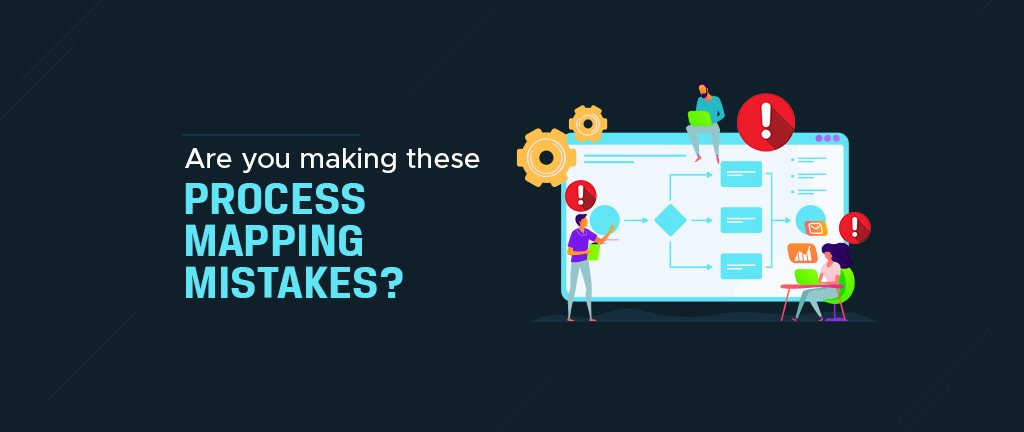Process mapping is the first critical step in your process improvement journey. It provides insights into key metrics, such as process duration, delay, execution time, bottlenecks, etc., to give a clear picture of what is working and what needs to be improved. Much of your process improvement success depends on the quality and effectiveness of your process maps.
Many times, organisations miss critical steps while developing the process maps so they end up gathering inaccurate or inadequate information, which leads to cascading impact on the entire improvement initiative.
This article talks about the 5 key mistakes to avoid at the process mapping stage to ensure the desired output from your project.
5 Key Mistakes to Avoid at the Process Mapping Stage
Not paying attention to process scoping and objectives:
Process scoping is an integral step in every mapping project as it involves clearly defining the start and end points and the boundaries of the process. Without an established boundary, there is a high chance of diverting from the process and the project losing direction.
Similarly, a lack of objective in terms of clearly defining the how and why of the project is another key reason for process mapping initiatives to get delayed or not deliver the desired output. Questions like why we need to map a particular process, what is the goal of process mapping (time saving, cost reduction, productivity, efficiency) and how to measure the success need to be answered to start the project on the right foot.
Developing process maps that are just boxes and lines
Creating a process map that is just a flowchart of your processes is not enough. Recording process attributes is a must to gain a 3D view and for overall analysis and improvement of the process. At a minimum, a process map needs to contain four distinct components i.e. a) Tasks, b) Roles, c) Documents, and d) Applications.
Tasks: Breaking down a process into several tasks gives a detailed view of all the process activities. It offers more efficient analysis and improvement opportunities through splitting, merging and reordering of tasks.
Roles: Defining the responsibilities of the people involved in the process not only increases efficiency but also helps ensure effective resource allocation.
Documents: Add the documents used throughout the execution of a process in the process map to ensure document consistency and proper data transfer across the organisation.
Applications: Mention all utilised applications in the process map. This highlights the possibility of using the application for other tasks in the process.
Creating process maps with multiple tasks
Your organisation is one long, interconnected process. However, putting too many tasks on one process map makes it difficult to understand and execute for the process doers. For ease of comprehension, the process needs to be broken into several logical manageable ‘chunks of information.’ The ideal length of a business process is between 5 and 20 tasks, which ensures the map is to the point and easy to understand.
Not focusing on the stakeholder interview
The importance of stakeholders’ interviews cannot be stressed enough. As they are involved in day-to-day activities, they can help you with unique insights into process pain points, delays, etc. However, organisations sometimes make the mistake of choosing the wrong stakeholder or multiple stakeholders for the process interview. To avoid any chaos or delay, make sure you identify the right stakeholder to interview. Also, a comprehensive set of pre-defined questionnaires needs to be kept ready to ensure the interview is to the point.
Not focusing on methodology and standards
In absence of defined methodology and standards, there will be inconsistent documentation across the organisation. To ensure consistent and accurate documentation for the organisation-wide processes, you must choose a worldwide accepted mapping notation, such as BPMN and define the right standards. Consistent documentation also proves vital in helping future-proof your initiatives. For instance, a repository of all process maps created using consistent symbols and notations comes in extremely handy for any future system implementation or digital transformation initiatives.
Choosing a cloud-based software, such as PRIME BPM helps you move past these mistakes by empowering you to create accurate and standardised maps within minutes. Packed with best-in-class functionalities, including one-click process prioritisation, the ability to record process attributes (Business Rules, KPIs, Text descriptions, Roles, Documents, etc.), and a built-in worldwide-recognised standard for process modelling, BPMN 2.0, helps you design accurate and standardised process maps without expertise.
To explore the full range of process modelling and improvement features in PRIME BPM, get access to PRIME BPM Premium at Zero Cost.


